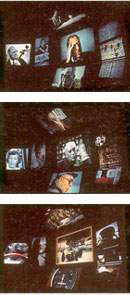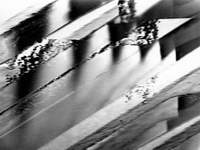Cinema's Future, Film's Afterlife
How is cinema affected by the transition from film to digitality? What of the cinematic imaginary in the age of the post-chemical moving image? ZKM’s blockbuster catalogue Future Cinema: The Cinematic Imaginary After Film, which accompanied its 2002-3 exhibition, achieves both exhaustive historical research and a reined-in utopian futurecasting
In the current climate around medical research on animals, it seems unlikely that Willy Kuhne would have been able to carry out his experiment on the nature of retinal vision in quite the manner he did:
"First, the rabbit’s head was covered to allow rhodopsin [a retinal pigment that bleaches in light] to accumulate in the rods [a type of receptor cell in the eye]. Then it was uncovered and held so that it faced a barred window. After a three-minute ‘exposure’, the animal was killed, its eye removed, and the rear half containing the retina ‘fixed’ in an alum solution so that the bleached rhodopsin could not be resynthesised."
The next day the preserved retina was found to retain "a picture of the window with a clear pattern of its bars".
Fans of Dario Argento, or neglected Hammer classic Horror Express, will recognise the folkloric motif of the image of violent death recorded in the victim’s retina. But the nineteenth century scientist’s decision to turn a rabbit into a pinhole camera has other relevances to cinema: it poses the question of just how far the analogy between the eye and the camera can be taken, and implicitly, where it is that cinema happens – ‘out there’, on the screen, or somewhere ‘in here’.
The story is recounted by William C. Wees in his essay ‘The Camera-Eye: Dialectics of a Metaphor’, published as a chapter in Future Cinema: The Cinematic Imaginary After Film, the catalogue for ZKM’s exhibition of the same name in 2002-3 curated by Jeffrey Shaw and Peter Weibel. Towards the end of this huge volume – Future Cinema is, in fact, so large that it is almost impossible to carry, let alone read – Weibel himself has an essay in which he extrapolates a cinematic trajectory from stills cameras which ‘imitated the organic technology of a natural apparatus’, through motion cameras, on to interactive images, ‘wireless neurocinema’, and ending with the hope of ‘liberating humanity from the natural prison of space and time’. The essay is a kind of microcosm of the catalogue as a whole, its flaws and its virtues: brilliant genealogies of cinema – its technologies, its locations, its rituals, its ideologies – backed by passionate and eclectic research, and yet prey to fits of futurecasting, vanguardism and pseudo-science.
The End of the End
A kind of ennui naturally settles in when the much recycled ‘end of cinema’ is rehearsed, one more time. Like the ‘post’ in postmodernism, the ‘end’ came too soon and has been for some time now. It is to its credit that Future Cinema is largely free of the musty smell we associate with the eager necrologists, and if anything it errs on the side of reckless optimism ('liberating humanity' etc).
 > Charles and Ray Eames, 'Think', multi-screen presentation, 1964................................................The first third of Future Cinema in particular is pleasantly loose and unprescriptive. In fact, it is an extraordinary source book of materials on cinema’s prehistory (the panorama, the diorama, the magic lantern and so on), its technical history (Cinemascope, VistaVision, Cinerama, Vitarama, 3-D in all its guises), its countercurrents (the Themersons, expanded cinema, multi-screen, the avant-gardes, etc) and its architectures (from the fairground to the multiplex). Nor is this simply a canter over familiar ground – the Eames’ World Fair multi-screen constructions may be familiar, for example, but they pale next to Czech artist Josef Svoboda’s ‘Polyrekan’ from the late 1960s: an installation involving 112 giant shifting cubes, each containing two slide projectors, and controlled by 240 miles of memory circuitry encoded onto a film strip.
> Charles and Ray Eames, 'Think', multi-screen presentation, 1964................................................The first third of Future Cinema in particular is pleasantly loose and unprescriptive. In fact, it is an extraordinary source book of materials on cinema’s prehistory (the panorama, the diorama, the magic lantern and so on), its technical history (Cinemascope, VistaVision, Cinerama, Vitarama, 3-D in all its guises), its countercurrents (the Themersons, expanded cinema, multi-screen, the avant-gardes, etc) and its architectures (from the fairground to the multiplex). Nor is this simply a canter over familiar ground – the Eames’ World Fair multi-screen constructions may be familiar, for example, but they pale next to Czech artist Josef Svoboda’s ‘Polyrekan’ from the late 1960s: an installation involving 112 giant shifting cubes, each containing two slide projectors, and controlled by 240 miles of memory circuitry encoded onto a film strip.
If there is a common thread which emerges from these histories, it is over a certain ontological uncertainty at the heart of what we call ‘cinema’. This uncertainty inhabits the gap between, on the one hand, those, like Stefan Themerson, who are convinced that cinema is a natural evolution from a fundamental human need (‘the urge to create visions’), possessed of a certain anthropological weight; and, on the other, those, like Bazin, who believe that ‘film is not an art form, [because] it is not the fulfilment of an eternal need or a newly created one’, that it is contingent and ‘mortal’. Obviously, questions such as Wees’ – about how much cinema’s technologies reflect and replicate human ways of seeing – will be left with little but reams of empirical data and decapitated rabbits if they do not grapple with these fundamentals.
It would be unhelpful to oversimplify, and few of these writers really inhabit either pole of the argument completely. But perhaps it is useful if, for example, one wished to understand the difference between a filmmaker like Stan Brakhage and his British Co-op contemporaries like Peter Gidal or Annabel Nicolson; Brakhage’s ‘art of vision’ always had a markedly anthropological bent, a desire to use the camera to recapture a more innocent ‘seeing’, whereas Gidal and many of the London Co-op generation of filmmakers foregrounded the guilt of the mechanism and its mediations.
Machine vision
It becomes clear too that this question of whether the ‘cinematic imaginary’ can transcend cinema, that is, film as we have known it, is going to be the motor for much of the theoretical work in the book – and in most cases, the answer is an emphatic yes.
 > Steina & Woody Vasulka, Spaces II, 1972..................................................................Weibel himself makes a useful distinction between the desire for ‘machine motion’ – that is, the ability to capture movement – and the desire for ‘machine vision’, that is, imitating and simulating human vision in its broadest sense. But the art of vision in this case is not the romantic one of Brakhage, or even the Themersons – Weibel instead cites as an example of the search for ‘machine vision’ Steina and Woody Vasulka, the American video pioneers who have recently had shows in Leeds and London. In Weibel’s conception this is seeing raised to the second power, ‘the seeing of seeing’ – technology, by mimicking human vision, revealing its parameters and then allowing us to transgress them.
> Steina & Woody Vasulka, Spaces II, 1972..................................................................Weibel himself makes a useful distinction between the desire for ‘machine motion’ – that is, the ability to capture movement – and the desire for ‘machine vision’, that is, imitating and simulating human vision in its broadest sense. But the art of vision in this case is not the romantic one of Brakhage, or even the Themersons – Weibel instead cites as an example of the search for ‘machine vision’ Steina and Woody Vasulka, the American video pioneers who have recently had shows in Leeds and London. In Weibel’s conception this is seeing raised to the second power, ‘the seeing of seeing’ – technology, by mimicking human vision, revealing its parameters and then allowing us to transgress them.
In his introduction, Jeffrey Shaw argues that, whereas the progressive trends in twentieth century cinematic practice were based around ‘playing against the apparatus’, the twenty-first century will see more attempts at ‘transforming the apparatus’. This means a move from, for example, artists hand-painting onto film, or using ‘expanded’ techniques or performance to interrupt patterns of spectatorship, towards what Weibel calls ‘a new class of experts, those individuals formerly called artists’, able to intervene and reprogram the technologies down to the smallest detail. In both Weibel and Shaw, the ‘cinematic imaginary’ is clearly thought to be in rude health and, if not quite instated as a full-blown anthropological fact, remains the container for a certain utopian confidence.
Fortunately for the book, this utopianism is not allowed full rein, for unchecked it tends towards the white-heat-of-technology, warp-factor-nine-Mr Sulu end of ZKM dottiness. Clearly, a lot of the works from the show suffer badly from being presented in book form; but they also suffer from sentences like, ‘The study aims to test the simple proposition that interactive narrative occurs as a function of the transportation of multi-modal information across virtual time’ – this in the context of an installation-cum-research project that involves something to do with a giant inflatable tent.
The eagerness to establish this ‘new class of experts’ and to forge forward to ‘the interactive image’ they will create for us, in which we can all be ‘internal observers’, tends to overshadow more cautionary, muddled assessments in which such hyperbolic theorisation, as Raymond Bellour puts it, ‘seems a bit premature’. Moreover, for all his noisy virtuosity, Weibel in particular seems very undiscriminating when it comes to particular works; strangest, given his evident immersion in the field, is his desire to restore narrative so firmly to centre stage and to make video art of the 1990s so congruent with practices of the 1960s and ‘70s. The attack on a mainstream cinema of pure spectacle looks anaemic when one can conclude that Douglas Gordon works ‘within the context of a deconstruction of the technical apparatus’; one does not have to sign up to the full-blown formalism of Nicky Hamlyn in his recent Film Art Phenomena to accept his criticism of Gordon and company for lacking precisely this self-reflexivity about the technologies involved.
Resentment & indifference
At this year’s Rotterdam Film Festival, Tsai Ming-liang’s Goodbye, Dragon Inn got a rough reception. In particular, the audience I saw it with hated the scene when the film settles down to a static shot of an empty cinema auditorium after the lights have gone up – the girl next to me started a slow hand-clap.
 > Tsai Ming-Liang, 'Goodbye Dragon Inn (Bu San)', Taiwan, 2003...............................................It is perhaps not a great film, but it was almost a great screening, precisely because of how successfully it stoked self-consciousness and, hence, resentment in its audience. Its long lingering scenes of people in the cinema, stressing their awareness of one another and all the suppressed libidinal energies at play in the dark, seemed to successfully destroy my audience’s immersion in the film.
> Tsai Ming-Liang, 'Goodbye Dragon Inn (Bu San)', Taiwan, 2003...............................................It is perhaps not a great film, but it was almost a great screening, precisely because of how successfully it stoked self-consciousness and, hence, resentment in its audience. Its long lingering scenes of people in the cinema, stressing their awareness of one another and all the suppressed libidinal energies at play in the dark, seemed to successfully destroy my audience’s immersion in the film.
When Shaw calls for a shift from the ‘autocracy of the director’ to an emphasis on a ‘personally discoverable periphery’, it’s hard not to feel he should stop and linger over this idea for a moment. Discounting for a moment the oddly residual auteurism of the formulation, it seems strange to think that audiences need their periphery on a plate; in fact, of course, people have always watched films for incidental pleasures as much as plot – Manny Farber’s whole body of writing is testament to this. Moreover, one of the greatest enduring pleasures of cinema as currently constituted is the bathos that is aroused by the discrepancy between the film being shown, with its irremediable universality – the universality that the dark is supposed to make you forget – and the place where you see it, the cinema, which is inevitably situated and particular. Of course, multiplexes have to some extent extended that bogus universality into the viewing space; but cinema as an experience remains about the continuing failure to conceal the fact that, as Godard put it, ‘in a cinema people are many (together) to be alone in front of a screen.’ Other people remain the personally discoverable periphery: the cinema is a social space under camouflage.
One of the least discussed aspects of the transplantation of ‘cinema’ from theatre to gallery shows like Future Cinema is that the film becomes ‘a work’, a singularity in a singular space. Cinema has experienced institutional critique, but it has never made anything like the impact it has in the visual arts; as a result, cinema spaces generally retain a certain indifference to what they show – an indifference, as I tried to suggest, which rubs up against the would-be universality of what is often on show. There is still work to be done in exploring and exploiting this indifference, with all the implications it has for audiences – audiences which after all are not so homogenous, in Delhi or New York or Dagenham.
Future Cinema is a generous contribution to the debate, not least in its copious research and lavish illustrations. But the futures of cinema needn’t occlude the afterlife of film, an afterlife we are very much still inhabiting.
Book: Future Cinema: The Cinematic Imaginary After Film Edited by Jeffrey Shaw & Peter Weibel, MIT Press, 2003, 0-262-69286-4
Exhibition: Future Cinema: The Cinematic Imaginary after Film. Curated by Jeffrey Shaw and Peter Weibel. 16 November 2002 - 30 March 2003, ZKM Karlsruhe
Mute Books Orders
For Mute Books distribution contact Anagram Books
contact@anagrambooks.com
For online purchases visit anagrambooks.com






